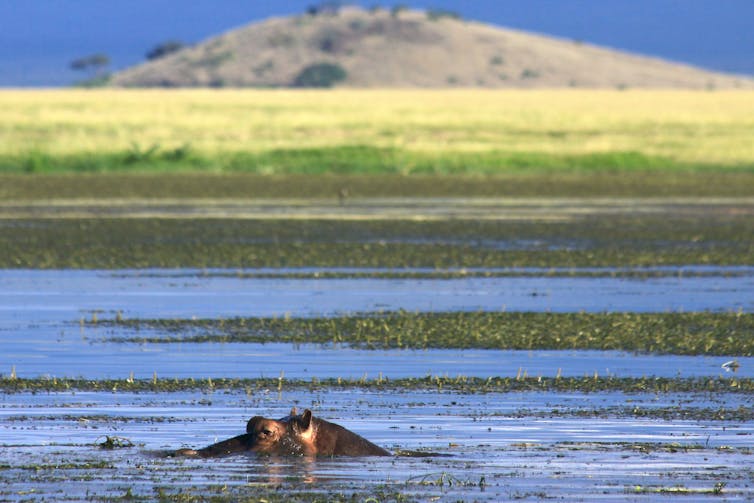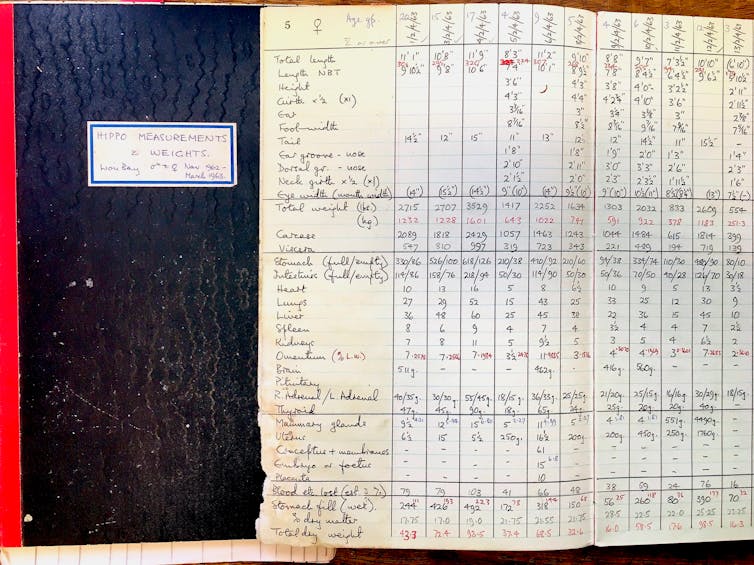Male hippopotamuses are an unusual size. Among mammals, males are usually much larger than females, but in hippos the sexes have surprisingly similar sized bodies. All except the jaws and tusks, which are much bigger in males.
Our recent research, using data uncovered from 60 years ago on nearly 3,000 hippos, suggests that their semi-aquatic behaviour may play a key role in minimising the size differences between the sexes.
Similar big mammals like elephants, lions and gorillas all display big differences in size between the sexes. The record-holding male southern elephant seal can weigh up to a staggering 3700kg, six times larger than the female (around 600kg).

User:Air55
Unlike these species, male hippos contest territory and fight over females in the water. (Even elephant seals fiercely defend their harems on land.) Water reduces the advantage of large body size in a territorial contest. And visually sizing up your rival is challenging when they are almost fully submerged. So male hippos commonly signal dominance by yawning and displaying the gape of their jaw and the size of their tusks, which appear to be more important than body size.
Hippos are one of the largest land mammals but consume comparatively small amounts of food due to a slow digestion rate, with research suggesting that they may already have reached the maximum body size that is physically possible with their physiology. They also commonly live in large groups, and food sources can be scarce. Evolution could therefore favour females that are larger bodied so they can compete for food and water.

Graeme Shannon
The hippo is one of the most well known large mammal species, and can be identified by children at an early age. But hippos are challenging animals to study. They spend most of their time in water only emerging at night to feed. Individual identification is difficult, and they are notoriously aggressive. They also have a fearsome reputation across the African continent.
As part of our research, we were fortunate to acquire a rare dataset on hippo body size, following an email from David Walton, a scientist at the British Antarctic Survey. His friend, the renowned zoologist and Cambridge University professor Richard Laws, died in 2014.
Laws left an impressive scientific legacy from 60 years of research ranging from Antarctica to the east African savannahs. His office was stacked high with notebooks and maps, which were at risk of being thrown out if we didn’t want them.

Graeme Shannon
We drove to Cambridge and came home with piles of notebooks containing rare and detailed measurements of 2,994 hippos collected from 1961 to 1966 in Uganda, all neatly recorded using imperial units. Laws had previously used the data to establish the age of each animal using their tooth size and wear.
We used the data to accurately explore the growth and body sizes of the sexes for the first time. Two master’s students at Bangor University worked to digitise and convert it to metric units and begin the analysis.
Read more:
The last time Earth was this hot hippos lived in Britain (that’s 130,000 years ago)
Given that male hippos compete fiercely for access to females, we fully expected that adult males would be significantly larger in body size and have bigger tusks. It came as a surprise to discover that males only weighed on average 5% more than females. Compare this with the African elephant, where mature adult males often weigh twice that of a fully grown female.
Intriguingly while body sizes were very similar, the data showed male hippos had much larger jaws and tusks than the females. These can be used to deadly effect during fights over territory. The tusks of an adult male hippo were almost double the size of those of an adult female (often exceeding 2kg).
Male mammals are thought to have evolved much larger body and weapon (tusks, horns, antlers) size than that of females due to the different mating strategies of the sexes. Females invest a huge amount of time and energy on pregnancy, lactation and weaning, while male input usually ends with successful copulation.
In species where a single male can mate with multiple females, the most dominant individual will likely father the most offspring. Male elephant seals commonly have harems numbering 40-50 females. As such, large body size is an excellent way to get an edge over your rivals.
However, as a result of finding this 60-year-old dataset, we now know a lot more about why the enigmatic hippo differs in this respect and this fascinating aspect of evolutionary biology. Our findings have revealed that intense male competition doesn’t always result in larger body size. In fact, the differences between males and females are also very much controlled by their environment, diet, and physiology.
![]()
The authors do not work for, consult, own shares in or receive funding from any company or organisation that would benefit from this article, and have disclosed no relevant affiliations beyond their academic appointment.











